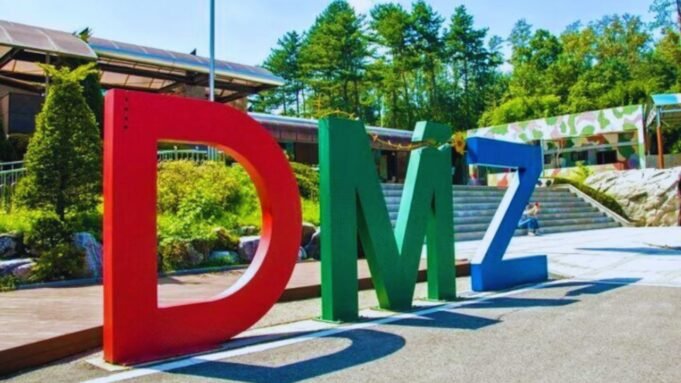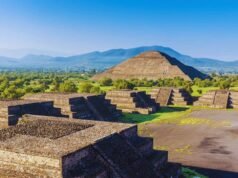The Demilitarized Zone (DMZ) is a thin strip of land serving as the buffer between North and South Korea, two nations still technically at war since hostilities ceased in 1953 after three years of intense conflict. This 4-kilometer-wide zone is heavily fortified, lined with barbed wire, and laden with landmines, making it one of the world’s most dangerous places.
Although largely undisturbed by humans, allowing nature to flourish, it is also a highly militarized area, patrolled by thousands of troops equipped with vast arsenals on each side.
The unpredictability of the DMZ led former US President Bill Clinton to call it “the scariest place on Earth” in 1993. While tourists are allowed in certain sections like the Joint Security Area through guided tours, much of the DMZ is inaccessible, branded as no-man’s-land.
Those daring to venture into this forbidden area, whether by accident or in desperate bids for freedom, often do not survive to share their experiences. For those who do make it out alive, crossing this perilous zone is a risk they feel compelled to take.
The DMZ has been the scene of numerous violent incidents over the years, including a brutal axe murder, a defector’s daring escape under gunfire, and the tragic shooting of a housewife. These events underscore the intense danger and volatility of this area.
The Dangerous History of the DMZ
The Korean peninsula has a painful history, suffering under the harsh rule of its neighboring superpowers, China and Japan. After World War II, the United States and the Soviet Union moved in to fill the power vacuum, invading from opposite ends of the peninsula. They soon agreed to divide the peninsula along the 38th parallel.
With the rise of Kim Il-Sung, a pro-communist leader, the first direct military engagement of the Cold War began in 1950 when 75,000 North Korean troops crossed the established division line.
While North Korea received indirect support from China and the Soviet Union, who were keen to spread their communist beliefs, South Korea was supported by the United States, which aimed to contain the spread of communism.
The conflict eventually reached a deadlock near the original dividing line. Both sides aimed to halt the conflict before direct Chinese involvement escalated it further, potentially sparking another world war shortly after the last had ended.
In July 1953, the Korean War concluded with a delicate ceasefire. The nations were divided by a 150-mile-long boundary that once again followed the 38th parallel.
The Demilitarized Zone (DMZ) was set up as a buffer zone, extending 1.2 miles (2 km) on either side of the line, creating a no-man’s land. The Joint Security Area (JSA) was also established as a crossing point where significant political meetings continue to occur. Since then, both nations have heavily fortified their borders, prepared for the possibility that the ceasefire might eventually break down.
Read More: American Airlines Flight Attendant
Types of DMZ Tours
The Demilitarized Zone (DMZ) between North and South Korea, a symbol of division and a relic of the Cold War, has become an intriguing destination for those interested in history, military affairs, and the dynamics of international relations. Several types of tours are available, offering visitors a range of perspectives and experiences in this unique area. Here’s a look at the various types of DMZ tours:
Panmunjom/Joint Security Area (JSA) Tours
These tours focus on the Joint Security Area in Panmunjom, the only part of the DMZ where North and South Korean forces stand face-to-face. It includes visits to the blue huts where negotiations have taken place over the years and the Freedom House from where you can view North Korean territory. This tour is heavily supervised and requires booking, given the sensitive nature of the area.
DMZ Peace and Security Tour
This tour offers a broader insight into the security situation on the Korean peninsula. It typically includes visits to key observation posts where tourists can look into North Korea, the Third Infiltration Tunnel—believed to have been planned for a military invasion by North Korea—and the Dora Observatory where visitors can see across the North Korean propaganda village.
Ecological Tour
Due to limited human activity, the DMZ has become an accidental nature reserve. The ecological tour focuses on the biodiversity and natural environment of the DMZ, including the rare species that thrive here. This tour might include walks through safe paths in the Civilian Control Zone (CCZ), which surrounds the DMZ, offering glimpses of untouched natural landscapes and wildlife.
Historical and Cultural Tour
This type of tour combines visits to the DMZ with stops at nearby historical and cultural sites. It might include trips to war memorials, museums like the War Memorial of Korea, and historical sites in nearby cities such as Seoul. These tours provide context to the Korean War and the subsequent division of Korea.
DMZ Documentary Tour
Some tours offer a more educational approach with documentary screenings and expert talks on the Korean conflict’s history and impact. These are particularly insightful for students or those deeply interested in understanding the geopolitical implications of the DMZ.
Combination Tours
Offering a mix of visits to the JSA, tunnels, observatories, and even nearby attractions like Nami Island or the Dorasan Station, the last train station before the North Korean border, combination tours are designed for those looking to get the most comprehensive experience of the area in a limited time.
Each tour type provides a different perspective on the DMZ, catering to various interests from intense historical and military insights to ecological and cultural experiences. Due to the security concerns and regulations governing visits to the DMZ, all tours are conducted by approved tour operators and require visitors to adhere strictly to safety instructions and schedules.
Why is the DMZ Considered by Many to be One of the Most Dangerous Places in the World?
Is the DMZ Really That Dangerous?
The Demilitarized Zone (DMZ) between North and South Korea is often perceived as one of the world’s most dangerous places due to its heavy militarization and historical volatility. While it is true that the area is fraught with landmines, armed soldiers, and military hardware, the perceived level of danger can be somewhat misleading for visitors. Tourist access is tightly controlled and limited to specific areas that are heavily secured and monitored, ensuring safety. Additionally, the regular presence of tourists and structured tours has normalized visits to certain parts of the DMZ over the years.
However, the underlying tension and the fact that North and South Korea are technically still at war mean that the area does carry inherent risks, underscoring the need for strict adherence to security protocols during visits. Thus, while it’s not as difficult for tourists as it might seem, the DMZ is still a high-security zone where safety depends heavily on following the guidelines and respecting the area’s solemn history.
Read Also: Do You Need a Passport to Go to Puerto Rico?
What Type of Boundary Dispute is the DMZ?
The Demilitarized Zone (DMZ) between North and South Korea represents a territorial boundary dispute, specifically categorized as a positional or definitional dispute. This type of conflict arises when two parties disagree over the interpretation of legal documents or maps used to define the boundary. In the case of the DMZ, the dispute stems from the Korean Armistice Agreement signed in 1953, which ceased hostilities of the Korean War and established the DMZ along the 38th parallel.
However, neither a peace treaty was signed nor was a final, formal border established, leaving the exact delineation and the sovereignty over certain areas ambiguous. This has resulted in a heavily fortified and vigilantly monitored border, with each side claiming sovereignty over the entire peninsula, thus continuing to fuel tensions and periodic confrontations within this buffer zone.
Why was the DMZ Created?
The Demilitarized Zone (DMZ) was created as a buffer zone between North and South Korea following the Korean War, which lasted from 1950 to 1953. The creation of the DMZ was part of the armistice agreement signed on July 27, 1953, which aimed to cease hostilities and establish a ceasefire between the two Koreas. The DMZ stretches approximately 250 kilometers (160 miles) across the Korean Peninsula and is about 4 kilometers (2.5 miles) wide. It was established to prevent further direct military confrontation between the North and South, serving as a physical barrier that both sides agreed to withdraw from to reduce the risk of accidental or deliberate military engagements.
The zone is heavily fortified on both sides by fences, landmines, and troops, making it one of the most heavily militarized borders in the world. The DMZ not only marks a stark division between the two Koreas but also stands as a poignant reminder of the unresolved status of the Korean War, as the armistice agreement was never followed by a peace treaty.
Read Also: Europe’s Most Loved Countries for New Travelers
What is the Border Between North and South Korea Called?
The border between North and South Korea is known as the Demilitarized Zone or DMZ. This 250-kilometer (155-mile) long and approximately 4-kilometer (2.5-mile) wide strip of land runs across the Korean Peninsula, roughly following the 38th parallel. Established by the armistice agreement that ended active combat in the Korean War in 1953, the DMZ serves as a buffer zone between the two countries, effectively preventing military engagements.
Despite its name, it is one of the world’s most heavily fortified borders, with a large concentration of troops and military installations on both sides. The DMZ stands as a stark symbol of the ongoing division and tension between North and South Korea.
Conclusion
The Demilitarized Zone (DMZ) between North and South Korea remains one of the most enduring symbols of Cold War division and the ongoing tension between the two Koreas. As a buffer zone, it not only prevents military conflicts but also serves as a poignant reminder of the unresolved state of war on the peninsula. Over the years, the DMZ has evolved into a unique ecological haven and a site of political and historical significance, attracting tourists from around the world who are eager to glimpse the reality of this frozen conflict.
The continuing existence of the DMZ underscores the complex interplay of diplomacy, military readiness, and hope for reunification that still influences Korean Peninsula relations today.















